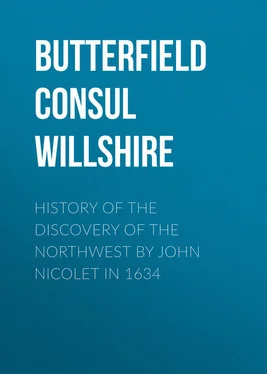Consul Butterfield - History of the Discovery of the Northwest by John Nicolet in 1634
Здесь есть возможность читать онлайн «Consul Butterfield - History of the Discovery of the Northwest by John Nicolet in 1634» — ознакомительный отрывок электронной книги совершенно бесплатно, а после прочтения отрывка купить полную версию. В некоторых случаях можно слушать аудио, скачать через торрент в формате fb2 и присутствует краткое содержание. ISBN: , Жанр: foreign_antique, foreign_prose, на английском языке. Описание произведения, (предисловие) а так же отзывы посетителей доступны на портале библиотеки ЛибКат.
- Название:History of the Discovery of the Northwest by John Nicolet in 1634
- Автор:
- Жанр:
- Год:неизвестен
- ISBN:http://www.gutenberg.org/ebooks/36698
- Рейтинг книги:5 / 5. Голосов: 1
-
Избранное:Добавить в избранное
- Отзывы:
-
Ваша оценка:
- 100
- 1
- 2
- 3
- 4
- 5
History of the Discovery of the Northwest by John Nicolet in 1634: краткое содержание, описание и аннотация
Предлагаем к чтению аннотацию, описание, краткое содержание или предисловие (зависит от того, что написал сам автор книги «History of the Discovery of the Northwest by John Nicolet in 1634»). Если вы не нашли необходимую информацию о книге — напишите в комментариях, мы постараемся отыскать её.
History of the Discovery of the Northwest by John Nicolet in 1634 — читать онлайн ознакомительный отрывок
Ниже представлен текст книги, разбитый по страницам. Система сохранения места последней прочитанной страницы, позволяет с удобством читать онлайн бесплатно книгу «History of the Discovery of the Northwest by John Nicolet in 1634», без необходимости каждый раз заново искать на чём Вы остановились. Поставьте закладку, и сможете в любой момент перейти на страницу, на которой закончили чтение.
Интервал:
Закладка:
Nicolet, while residing with the Algonquins of Isle des Allumettes, with whose language he had now become familiar, accompanied four hundred of those savages upon a mission of peace to the Iroquois. The voyage proved a successful one, Nicolet returning in safety. Afterward, he took up his residence among the Nipissings, with whom he remained eight or nine years. He was recognized as one of the nation. He entered into the very frequent councils of those savages. He had his own cabin and establishment, doing his own fishing and trading. He had become, indeed, a naturalized Nipissing. 6 6 "Il [ Nicolet ] accompagna quatre cents Algonquins, qui alloient en ce temps là faire la paix auec les Hiroquois, et en vint à bout heureusement. Pleust à Dieu qu'elle n'eust iamais esté rompuë, nous ne souffririons pas à present les calamitez qui nous font gemir et donneront vn estrange empeschement à la conuersion de ces peuples. Apes cette paix faite, il alla demeurer huict ou neuf ans auec la nation des Nipissiriniens, Algonquins; là il passoit pour vn de cette nation, entrant dans les conseils forts frequents à ces peuples, ayant sa cabane et son mesnage à part, faisant sa perche et sa traitte." – Vimont, Relation , 1643, p. 3.
The mental activity displayed by him while sojourning among these savages may be judged of from the circumstance of his having taken notes descriptive of the habits, manners, customs, and numbers of the Nipissing Indians, written in the form of memoirs, which were afterward presented by him to one of the missionaries, who, doubtless, made good use of them in after-time in giving an account of the nation. 7 7 "I'ay quelques memoires de sa main, qui pourront paroistre vn iour, touchant les Nipisiriniens, auec lesquels il a souuent hyuerné." – Le Jeune, Relation , 1636, p. 58.
Nicolet finally left the savages, and returned to civilization, being recalled by the government and employed as commissary and Indian interpreter. 8 8 "Il [ Nicolet ] fut enfin rappallé et estably Commis et Interprete." – Vimont, Relation , 1643, p. 3.
It is probable, however, that he had signified his desire to leave the Nipissings, as he could not live without the sacraments, 9 9 "Il [ Nicolet ]… ne s'en est retiré, que pour mettre son salut en asseurance dans l'vsage des Sacremens, faute desquels il y a grande risque pour l'âme, parmy les Sauuages." – Le Jeune, Relation , 1636, pp. 57, 58.
which were denied him so long as he remained with them, there being no mission established in their country. 10 10 It would be quite impossible to reconcile the Relation of 1643 (p. 3) with that of 1636 (pp. 57, 58), respecting Nicolet's retiring from his Indian life, unless he, for the motive stated, asked for his recall and was recalled accordingly.
Quebec having been reoccupied by the French, Nicolet took up his residence there. He was in high favor with Champlain, who could not but admire his remarkable adaptation to savage life – the result of his courage and peculiar temperament; at least, this admiration may be presumed, from the circumstance of his having, as the sequel shows, soon after sent him upon an important mission.
Whether Nicolet visited Quebec during his long residence among the Nipissing Indians is not known. Possibly he returned to the St. Lawrence in 1628, to receive orders from Champlain on account of the new state of things inaugurated by the creation of the system of 1627 – the Hundred Associates; but, in that event, he must have soon returned, for it is known that he remained with the Nipissings during the occupation of Quebec by the English – from July, 1629, to July, 1632. The month during which, in the early days of New France, the trade of the Ottawa was performed on the St. Lawrence, was July; and, in 1632, this trade was largely carried on where the city of Three Rivers now stands, but which was not then founded. 11 11 Champlain's map of 1632 shows no habitation on the St. Lawrence above Quebec. In 1633, Three Rivers was virtually founded; but the fort erected there by Champlain was not begun until 1634. – Sulte's Chronique Trifluvienne , p. 5. "As for the towns in Canada, there are but three of any considerable figure. These are Quebec, Montreal, and Trois Rivieres [Three Rivers]… Trois Rivieres is a town so named from its situation at the confluence of three rivers, one whereof is that of St. Lawrence, and lies almost in the midway between Quebec and Montreal. It is said to be a well-built town, and considerable mart, where the Indians exchange their skins and furs for European goods." — An Account of the French Settlements in North America , Boston, 1746, pp. 12, 14. "Three Rivers, or Trois Rivieres, is a town of Canada East, at the confluence of the rivers St. Maurice and St. Lawrence, ninety miles from Quebec, with which it is connected by electric telegraph, and on the line of the proposed railway thence to Montreal. It is one of the oldest towns in Canada, and was long stationary as regarded enterprise or improvement; but recently it has become one of the most prosperous places in the province – a change produced principally by the commencement of an extensive trade in lumber on the river St. Maurice and its tributaries, which had heretofore been neglected, and also by increased energy in the manufacture of iron-ware, for which the St. Maurice forges, about three miles distant from the town, have always been celebrated in Canada. Three Rivers is the residence of a Roman Catholic bishop, whose diocese bears the same name; and contains a Roman Catholic cathedral, a church of England, a Scotch kirk, and a Wesleyan chapel, an Ursuline convent, with a school attached, where over two hundred young females are educated; two public and several private schools, a mechanics' institute, a Canadian institute, and a Young Men's Improvement, and several other societies. It sends a member to the provincial parliament. Population in 1852, was 4,966; in 1861, 6,058. The district of Three Rivers embraces both sides of the St. Lawrence, and is subdivided into four counties." — Lippincott's Gazetteer , Philadelphia, 1874.
The flotilla of bark canoes used to spend usually from eight to ten days in that place – seldom reaching Quebec. In the month and the year just mentioned, De Caen arrived in Canada; and he was, therefore, in the position to send word, by the assembled Indians, to the French who were living among the savages upon the Ottawa and the Georgian bay of Lake Huron, requesting their return to the St. Lawrence.
Champlain, in June, 1633, caused a small fort to be erected about forty miles above Quebec, for the rendezvous of the trading flotilla descending the St. Lawrence – to draw the market nearer Quebec. It was thus the St. Croix fort was established where the trade with the Indians would be much less likely to be interrupted by incursions of the Iroquois than at Three Rivers. At this time, one hundred and fifty Huron canoes arrived at the newly-chosen position, for traffic with the French. Possibly so great a number was the result of the change in the government of the colony – the return of the French to Quebec the preceding year. With this large fleet of canoes Nicolet probably returned to civilization; for it is certain that he was upon the St. Lawrence as early as June, 1634, ready to embark in an undertaking which, of necessity, would have caused so much consultation and preparation as to preclude the idea of his arrival, just then, from the Ottawa. An Indian interpreter – one well acquainted with the Algonquins of the Ottawa, and to a certain extent with the Hurons of Georgian bay – who could Champlain more safely depend upon than Nicolet to develop his schemes of exploration in the unknown western country, the door of which he had himself opened in previous years? Who was there better qualified than his young protégé , familiar as he was with the Algonquin and Huron-Iroquois tongues, to hold "talks" with savage tribes still further west, and smoke with them the pipe of peace – to the end that a nearer route to China and Japan might be discovered; or, at least, that the fur-trade might be made more profitable to the Hundred Associates? Surely, no one. Hence it was that Nicolet was recalled by the governor of Canada.
Читать дальшеИнтервал:
Закладка:
Похожие книги на «History of the Discovery of the Northwest by John Nicolet in 1634»
Представляем Вашему вниманию похожие книги на «History of the Discovery of the Northwest by John Nicolet in 1634» списком для выбора. Мы отобрали схожую по названию и смыслу литературу в надежде предоставить читателям больше вариантов отыскать новые, интересные, ещё непрочитанные произведения.
Обсуждение, отзывы о книге «History of the Discovery of the Northwest by John Nicolet in 1634» и просто собственные мнения читателей. Оставьте ваши комментарии, напишите, что Вы думаете о произведении, его смысле или главных героях. Укажите что конкретно понравилось, а что нет, и почему Вы так считаете.












